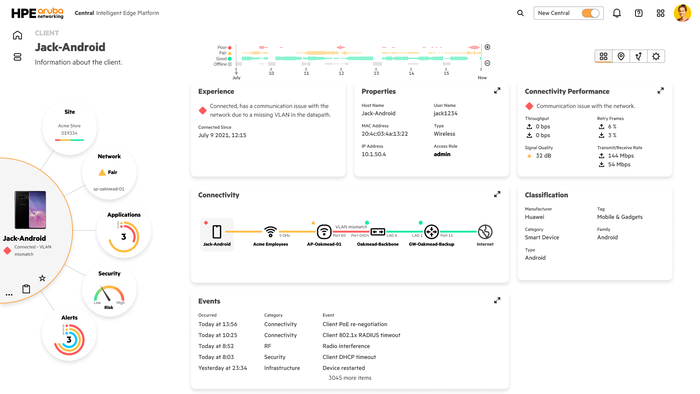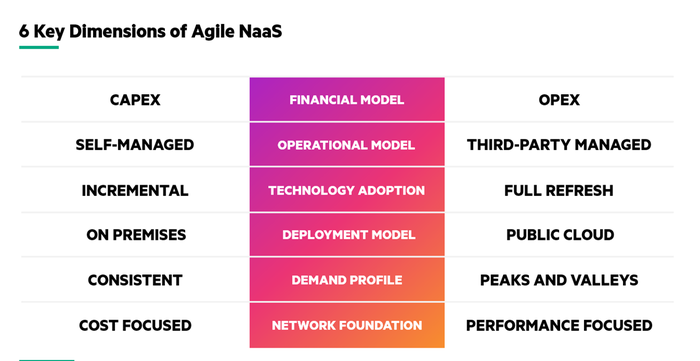HPE Bolsters Aruba Central Platform, NaaS StrategyHPE Bolsters Aruba Central Platform, NaaS Strategy
HPE's intelligent edge division rolled out a ninth service pack for network as a service.

ARUBA ATMOSPHERE — Aruba Networks has redesigned its Aruba Central platform to help short-staffed IT teams more effectively use AIOps for network management.
Aruba at its annual conference on Tuesday in Las Vegas announced the newest version of its cloud-native Aruba Central platform, which now includes a “solar system” view of the network that executives say will give users a simplified experience. Other updates to the portal include a “point-in-time” view that lets IT teams and MSPs view historical network data.
These changes will help solve two interrelated challenges for businesses and the partners that serve them. On one hand, networking teams face a talent shortage and frequently hire less specialized personnel to handle network. At the same time, networks are growing more complex, distributed and fragmented.

Aruba’s Larry Lunetta
“It doesn’t matter who manages the network,” said Larry Lunetta, Aruba’s vice president of portfolio solutions marketing. “It could be Aruba, it could be the customer, and increasingly, it can be a channel partner. What next-generation Central represents is the efficiencies that they need to be successful. In other words, you can’t throw bodies at this. You’re going to need this kind of topology view and automation to make the job of managing a network simpler and successful.”
In addition, the networking vendor unveiled an Agile NaaS (network as a service) framework. The framework outlines six key ways in which business may choose to deploy and consume and manage NaaS differently. The vendor also unveiled a ninth SKU for NaaS that channel partners can sell.

Aruba’s Phil Mottram
“A modernized network is the backbone for powering next-generation digital experiences and enabling new business models,” said Phil Mottram, executive vice president and general manager, HPE Aruba Networking. “The evolution of our AIOps in HPE Aruba Networking Central and Agile NaaS represents the next step toward more effectively managing operational complexity, while connecting with ever-expanding workloads from edge to cloud for a seamless hybrid work experience.”
HPE (then under the banner of Hewlett-Packard) acquired Aruba in 2015 with the intention of bolstering its wireless and campus networking portfolio. Now Aruba plays a starring role as HPE’s intelligent edge business, having driven $1.1 billion in first-quarter revenue for its parent company, with 22% growth in operating profit margin.
Aruba Central Platform
Aruba first introduced its network management platform in 2014. Lunetta called Aruba Central one of the first its peers to focus on migration from on-premises to the cloud. Now the Aruba Central platform sits alongside parent company HPE’s GreenLake edge-to-cloud platform. And Aruba Central manages “hundreds of millions” of devices associated with “tens of thousands” of customers, Lunetta said.
“We believe that we have the largest integrated network data lake in the industry, based on all those customers and all those devices that we’ve been managing for a number of years,” Lunetta told Channel Futures. ” As everyone is starting to see, even in the popular press, the more data you have for AI, the better it gets.”

Lopez Research’s Maribel Lopez
Maribel Lopez, founder and principal analyst at Lopez Research, said IT teams need tools to manage the modern network. However, she said many network professionals say their management tools are underperforming.
“Companies need a new generation of management tools that are built for an AIOps environment, with unified workflows from day zero planning to day one deployment and day two troubleshooting and optimization, ultimately allowing the needs of the business to drive timelines for technology and the network — not the other way around,” Lopez said.
Aruba has introduced a solar system view, whose topology executives say allows users to visualize a large network by moving outward from one entity to another.
“If at the store level, the analysts see the client or application has a significant number of problems, they can click on that, and the application or the client becomes the center of the solar system, and all the other elements are arrayed that are in context with that particular review,” Lunetta said. “What we’re trying to do is …
… avoid the classic tabs across the top of the page and tabs across the bottom of the page that require a lot of clicks to get what you need.”

Source: HPE Aruba
Network ‘Time Travel’
The Aruba Central Platform now allows IT teams to view the state of the network environment at a particular point in time. Lunetta said this solves the problem of network issues that require a historical view.
“That typically requires a senior network engineer with very specific skills around capturing packets and interpreting what they mean using a tool such as Wireshark,” Lunetta said. We’ve taken seven days’ worth of data in terms of how the network has performed and how it’s operated, and stored that away. And the time travel capabilities now will allow a networking team to go back over those seven day … and see what the status of the network was at a [certain] point in time as if they were in real-time.”
Agile NaaS
Aruba rolled out an Agile NaaS framework, which does not function as a product or SKU; rather, it functions as a self-service guide that customers and partners use to determine exactly what network as a service should look like for the customer. Because, Lunetta emphasized, NaaS comes in all shapes and sizes. But many customers are getting confused by messaging in the market about the diversity of NaaS, he said.
“A lot of customers are coming to us saying they’re confused. They don’t know how to implement it. Moreover, they’re hearing from industry analysts, certain parts of the press and certainly some vendors that there’s one-size-fits-all for NaaS, and if you don’t do it by these four steps, you’re not doing network as a service. We have a lot of experience managing customer networks now, and that’s simply not the case,” he said.
Customers need choice in how they acquire, deploy and manage network services, Lunetta said. He added that the new framework can help them determine their requirements and guide them in purchasing a solution.
NaaS Components
The frameworks break down into six different categories.
The first distinguishes capex vs. opex as the preferred model. And although the one-time nature of capex may seem to go against the tenets of an as-a-service offering, Lunetta said some customers prefer to buy part of the offering upfront.
“We have had customers say, ‘Look, I just got some extra capital. I want to buy the hardware and basically take the software and support on a monthly basis.’ We will certainly allow them to do that,” he said.
As for the operational model, some businesses prefer to manage the offering themselves. Others prefer for Aruba or a partner to provide a managed service.
Another NaaS dimension is how customers want to adopt the technology. Do they want to fully refresh their environment or implement new offerings incrementally? Lunetta said the latter is more popular.
“Almost nobody we talk to implements network as a service across their entire network, where it’s a rip and replace. It’s generally a new project — a new initiative where they’re starting to see the need for supplements in terms of resources, better cash flow associated with the initiative, etc.,” Lunetta said.

Source: HPE Aruba
Moreover, some customers want to deploy NaaS on-prem, while others want to do it over the public cloud. But when they do use public cloud, customers differ on whether they want to flex their costs on a monthly basis. Lunetta said many customers initially jumped at the opportunity with NaaS to fine-tune their financial commitments. But many of them have gotten sticker shock from higher-than-expected monthly bills from the cloud provider.
“We’ve done a lot of surveys with customers and C-level executives. And increasingly they’re saying they want a consistent bill,” he said. “They want a monthly bill they can count on so that they’re not surprised, and we think that’s a very legitimate choice compared to flex-up-flex-down.”
Finally, some customers are focusing on cost as their network foundation, while others focus on performance, Lunetta said.
Brandon Butler, IDC research manager for enterprise networks, said businesses are increasingly seeking to …
… establish agile, responsive and simple-to-operate networks.

IDC’s Brandon Butler
“HPE Aruba Networking has recognized that each organization has unique needs and is at the forefront of reinventing how customers and partners can consume or deliver more business-outcome focused networking,” Butler said. “With the enhancements announced today, HPE Aruba Networking continues to advance its mature portfolio in the areas of AI, security, automation, and network as a service.”
NaaS Service Packs
Aruba announced a new service pack for Network Policy NaaS. This SKU – Aruba’s ninth for NaaS – revolves around the Aruba ClearPass Policy Manager. It focuses on network access control and security, Lunetta said. It will enter general availability in HPE’s third quarter of 2023, which runs through July.
Aruba in 2022 introduced eight SKUs for NaaS, which it referred to as service packs. Those service packs feature hardware, software subscription and support and services, all wrapped into a single SKU. The previous service packs had centered around wired, wireless and SD-branch, respectively.
And Lunetta said Aruba will start introducing new service packs at a faster rate going forward.
“It took us a little longer to get to general availability on the original service packs,” Lunetta said. “As you can imagine, there are a lot of back-office things that we have to get right in terms of ordering and inventory management.”
Aruba originally took a more direct-focused, bespoke approach to a very small number of enterprise NaaS customers. But the vendor choose to open up a more commercially broad portfolio that partners would lead.
“We see this as a great expansion in our business. We believe we’re a leader in network as a service. But the way we’re really going to accelerate that growth is with partners. We don’t have enough resources to manage everybody’s network. But in aggregate, our channel partner community is a great resource for us to tap into to really extend our NaaS footprint.”
Joel Grace, senior vice president of client services for Aruba partner Sayers, pointed to the value of the service packs.

Sayers’ Joel Grace
“With network operations under pressure from a combination of the IT skills shortage, data complexity and fragmented network operations requirements, many enterprise customers are looking to automate more of their network management operations — and at the same time use AIOps to streamline delivery of network as a service,” said Grace. “HPE GreenLake for Aruba networking service packs are exactly what our customers need to build and run an edge-to-cloud infrastructure in one place and pay for it all as a service.”
M&A Integration
Aruba has reportedly integrated the technology of Axis Security into its networking portfolio. HPE in March announced its acquisition of Axis, which provides zero-trust network access (ZTNA), secure web gateway (SWG) and cloud access security broker (CASB). The acquisition closed in March.
“We will blend that into the Aruba [platform], and then we’ll have a full SASE offer,” Mottram told Channel Futures in March.
In the meantime, HPE said it will eventually integrate solutions from Athonet, which it recently announced plans to buy, into the Aruba portfolio. The deal reportedly will close in HPE’s fiscal fourth quarter, which starts in August. Athonet provides 4G LTE and 5G mobile cores. According to Aruba’s Tuesday news release, Athonet solutions will integrate into Aruba’s portfolio and existing telco software.
Mottram told Channel Futures last month that his team plans to integrate Athonet’s private 5G services onto the Aruba Central platform. However, they are holding off on integrating Athonet onto Aruba Wi-Fi access points for now.
Want to contact the author directly about this story? Have ideas for a follow-up article? Email James Anderson or connect with him on LinkedIn. |
About the Author
You May Also Like


